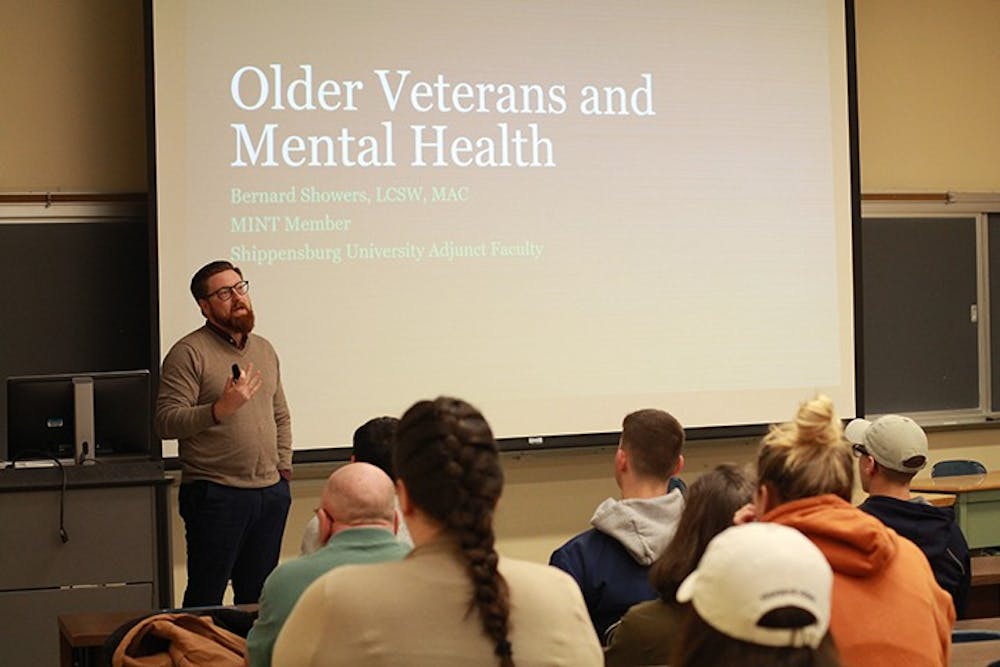Shippensburg University alumnus and current adjunct social work professor Bernard Showers led a discussion in a crowded Shippen Hall lecture room Monday evening on older veterans and mental health issues.
Showers, a licensed social worker in Pennsylvania who works at the Department of Veterans Affairs in Lebanon, opened the floor for discussion at the beginning of his presentation by asking the audience what they think is important for others to know regarding overall military culture.
“PTSD,” one student said.
“I think they want respect that they may have not gotten,” another said.
Showers explained military culture is comprised of values, beliefs, traditions, norms and perspectives. The lecture focused on Vietnam-era veterans, the largest group from any war with 7.2 million veterans.
“Over 50 percent of men ages 60-65 are Vietnam War veterans,” Showers said.
Showers emphasized the unpopularity of the Vietnam War, and the negative perception it had by many soldiers after being forcefully drafted.
He also noted the high rates of post-traumatic stress disorder (PTSD) among Vietnam veterans, calling out the lack of screenings and treatment of soldiers when they returned home.
“For a long time, there was this stigma attached to it. They said, ‘You know what, I’m gonna pick myself up by my boots, I’m gonna walk this off, and just deal with it.’ And frankly, in my experience, a lot of people did just that — remarkably,” he said.
Although the history of mental health treatment in the military has come a long way, the stigma started early. During World War I, soldiers showing psychological symptoms associated with their combat experience were diagnosed with war neuroses, or shell shock, and often times seen as cowardly by their leaders. In 1927, the percentage of all hospitalized servicemen defined as “neuropsychiatric cases” nearly doubled from 27 percent in 1921.
During World War II, more psychiatrists focused on the importance of soldiers returning to the workforce, moving away from long-term hospitalization. World War II also saw the introduction of the G.I. Bill, which gave benefits to World War II veterans.
Yet 15 years after the U.S. withdrew from Vietnam, it was found that 480,000 — 15 percent of the 3.15 million Americans that served in Vietnam — were suffering from service-related PTSD.
“Before the war, psychiatric consensus held that soldiers who recovered from an episode of mental breakdown during combat would suffer no adverse long-term consequences. As we know now, that is absolutely not the case,” Showers said.
Today, many people recognize the correlation between mental illness, such as PTSD, and serving in war. Showers discussed the growing topic of moral injury, which affects soldiers once they return home.
“There is this sense of cognitive dissonance — they feel morally conflicted,” Showers said.
Attendees were provided with tips and actions they can follow to help older veterans and adults with mental health issues. Showers urged the audience to become more informed about veteran care benefits and the services veterans may be eligible for, such as HUD-VASH—a collaboration between Section 8 housing and the Department of Veterans Affairs (VA) which helps chronically homeless veterans obtain apartments through Section 8, and maintain them with supportive case management through the VA. Showers also told the audience to be patient and mindful of bias and stereotypes when communicating with older adults.
Showers ended the discussion by describing different types of services and intervention for older veterans suffering from mental health issues.
“You can certainly see where we’ve come in terms of treatment and our understanding of mental health. There’s a long, long, long way to go,”Showers said. “It’s still a really, really young field, but if we could see just between when folks return from Vietnam to now, and all of these evidence-based practices that we know can be effective for a variety of mental health disorders.”





The Slate welcomes thoughtful discussion on all of our stories, but please keep comments civil and on-topic. Read our full guidelines here.